Apple's iPad - The AnandTech Review
by Anand Lal Shimpi, Brian Klug & Vivek Gowri on April 7, 2010 9:39 PM EST- Posted in
- Smartphones
- Mac
- Apple
- iPad
- Mobile
Reading Rainbow
The first time you launch the App Store, it prompts you whether you'd like to install the iBooks application. It's puzzling that iBooks isn't installed by default - perhaps it wasn't finished by the time Apple started flashing EEPROMs for production. Whatever the case, Apple definitely wants you to install their books and reading application immediately upon launch. Until something better comes out, there admittedly isn't any reason you shouldn't.
iBooks is fairly minimalist in its initial presentation, there's no organization or categorization to speak of, just virtual shelves that your "books" sit on. It'd be nice to have some organization here, lest the same kind of icon hell happen with books instead of applications now.
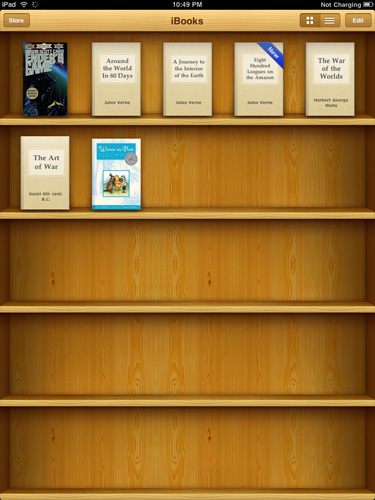
I totally put my real books in bookshelves with their front covers facing out, too
Inside, Apple has crafted a virtual book layout complete with some flashy 3D page turning animations. There's even transparency on the backsides of pages when viewing them in portrait mode.
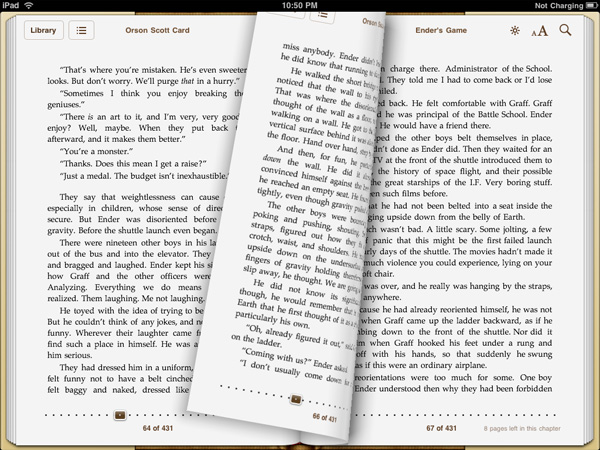
Ooh look at the flashy page turn animations
Controls for brightness, text size, and search adorn the top corner, and a slider at the bottom lets you quickly scrub through the book. You can't flick pages quite as fast as you can in a real book, but it's decently fast. Tapping on words in the body of the text brings up the normal copy dialog, but there's also dictionary, bookmark, and search. Bookmarking puts a faux highlighter mark on the selection, and makes a bookmark. Dictionary pops up an OS X dictionary widget-like popover with the word's definition. Search, well, searches.
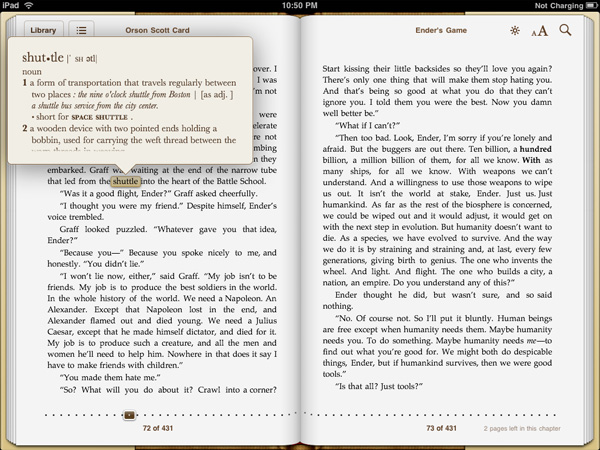
I regularly ride my space shuttle to Boston, er, what?
The store itself is relatively limited in scope this far - searching through it for many of the classics I love revealed that they weren't yet included. Free books from Project GutenbergOrganization and appearance is just like the App Store, except with books. That means ratings, categories and featured are all there as well. The reviews themselves are still getting fleshed out; it's a bit unnerving to see one star ratings on timeless classics, but all of that same goodness from the App Store is here in the book store. Nominal price seems to be somewhere around $9.99, though prices are bracketed by the occasional $14.99 or $8.99 book.
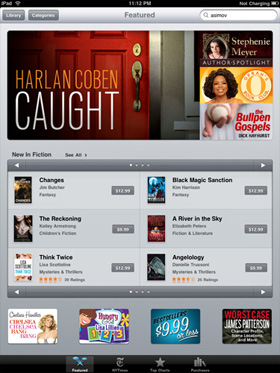 |
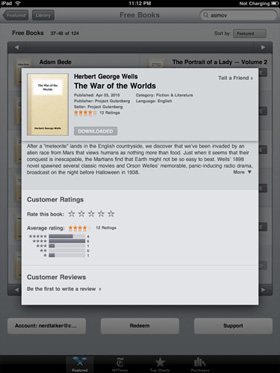 |
Books sync back to iTunes, but you can't open them. In addition, it's apparent that the book store is segmented from the App store somehow, as you cannot buy books in iTunes from the iTunes Store and load them on the iPad. The iBook application fully supports the ePub format for books as well.
Other Reading Apps
If reading through iBooks isn't your thing, there are other ways of consuming print media on the iPad, but for those, you'll have to go install an app.
Case in point are PDFs; if left to using the OS' PDF reader, your only options are either browsing online or as email attachments, and both of those get old fast. Though the default reader works, its typical Apple minimalist style leaves out just about everything that makes modern PDF readers, modern. You can view the document; that's it. If you're serious about reading PDFs, one of the best applications for the iPhone was GoodReader, and its developers launched an iPad compatible version day one. Layout is essentially the same as it was on the iPhone version, just larger and more readable.
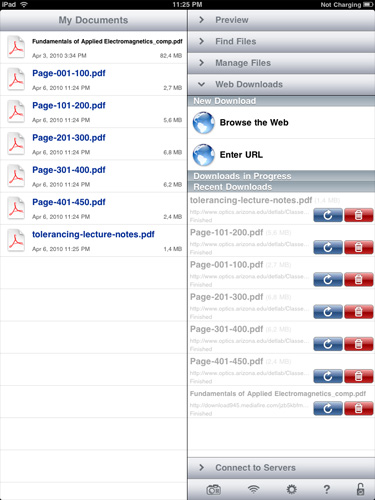
PDFs and Text files can either downloaded from the web or email, or loaded over WiFi, WebDAV, Google Docs, Dropbox or FTP, and are then stored locally. In addition to being noticeably faster than the OS' PDF viewer, there's also an interface complete with bookmarks, search, view, reflow, and even auto scrolling. If you've already got an expansive library of books or notes in PDF form, this is the optimal way to view them for now.
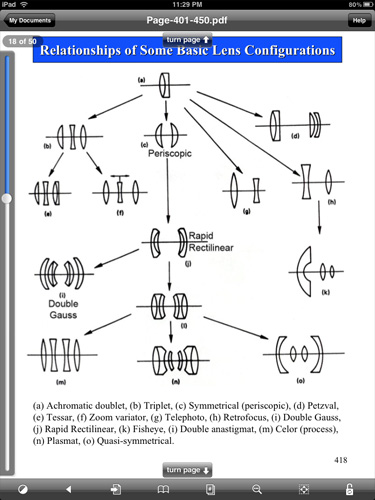
For students, the majority of material is passed down in PDF form; it's nice to finally see a polished document reader for one of the most veteran document formats. In practice, this is the way that iPhone OS' PDF reader should work out of the box.
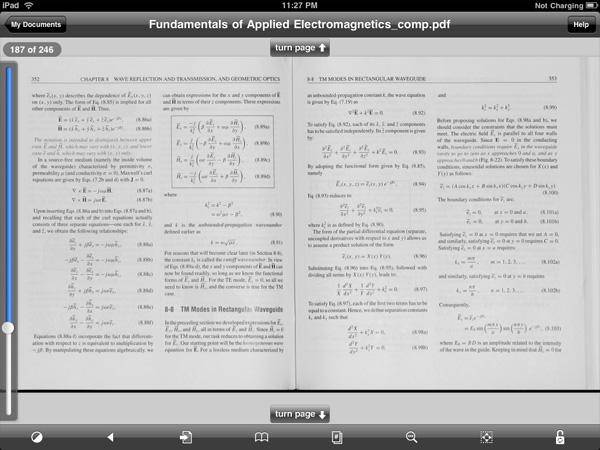
Of course, there's also the Kindle app which has adopted a similar style to the iBooks app, complete with animated 3D page turns, a grid layout, and the like. It's a great utility if you're already invested in a virtual library of Kindle books. If you haven't seen it by now, there's also the Marvel comic book reader. The iPad's usefulness as a book and print media reader is still evolving, but the primary players are still News.
Media - News
The iPad has become something of a messiah for mainstream print media hoping to finally offer a brave new business model for media consumption. Basically all the major press has their own dedicated newsreader or news-zine application, and this is simultaneously great, and destructive for the platform. On one hand, the iPad is a unique way to consume media tailored to a common device form factor - it's no coincidence that the thing is roughly the size of a magazine. On the other, each of the experiences media venues offer is radically different. One thing is for certain, it's unclear what users will ultimately prefer - tailored experiences delivered through venue-specific applications, or simply getting the same content online.
Of course, there are strings attached in the form of subscriptions. There are two ends of the spectrum here - one offers free media, the other is a subscription or issue based model for all your reading habits. Applications like NPR, Bloomberg, BBC News, NYT, Reuters, USA Today and the Associated Press all offer AD-subsidized or essentially free media consumption. There's the occasional inline or application launch advertisement, but most of it is relatively unobtrusive.
Wall Street Journal, Time, GQ and others instead only offer in-application subscription or purchase. Will people consume media and tolerate the occasional AD, or is subscription the only way to monetize the iPad? The subscription model battle that some media venues are hoping will save their publications will likely be fought partly on the iPad and other converged distribution platforms.
Utility, Entertainment and Social Media
At least thus far, it seems as though a lot of applications have taken a nod from Apple's Mail application design - a quarter width tab at left with information, and a dominant panel for more focus at right. It's obvious that developers used to working on the relatively cramped layout of the iPhone still haven't found the optimal use layout for the iPad's larger screen, but this two panel approach nearly mitigates lack of multitasking for some use scenarios.
The best of example of which is side by side Twitter with web browsing. If any of you are like me, you likely browse with a Twitter client open on one side of the screen and a browser on the other - offering you a glance at what's going on alongside the program in which to view it. This is exactly what TweetBrowser offers, and I think it's the kind of new use scenario that will distinguish the iPad from its smartphone brethren. In time, we'll likely see more efficient use of screen real-estate in other applications, which TweetBrowser does already.

TweetBrowser - Best of all, it's free
Another awesome use of the newfound real-estate is in TweetDeck for iPad. Landscape mode offers a view of all your default tabs and searches, while portrait mode lets uses the vacant space at top to display tweets in detail view, or a browser for links.















108 Comments
View All Comments
strikeback03 - Friday, April 9, 2010 - link
My carputer runs fine with temps in the car over 100*F.Mumrik - Thursday, April 8, 2010 - link
Man! You guys must really have been in a hurry to get this review up.It is long, critical and thorough as I expect from you, but there are quite a lot of grammatical errors and you repeat yourself a lot i places. :-D
Sunburn74 - Thursday, April 8, 2010 - link
Anand,When you read the rhetoric between the gtx 470/480 reviews, your most recent Macbook pro reviews, and your current iPad review, its clear the latter is by far the single largest fluff piece ever posted on this site. You seem to have forgotten that people come to your site for one reason. We are the unknowing consumers who turn to your impartial judgement with one, and only one question: should we buy it?
Ryan Smith's gtx 470/480 review was superb. He didn't write "I could see myself buying a $500 gtx 480 for my 4th PC on summer trips to my house in the hamptons where I don't have to be using my real desktop for any real work". He flat out said "Nvidia was too little, too late". He didn't try to sell anyone on what might possibly be on some distant horizon in the upcoming future if you had the extra money; he delineates whether or not people should buy the item right now.
When future potential arrives, then you write another article explaining how the landscape has changed. Anand, your latest article shamelessly bent over backwards to positively sell the iPad in this way. How about comparing the ipad to the ipod touch, the iphone, the blackberry, the android, and explaining if people who own these items that deeply saturate our society what the iPad means to them? How about answering the bottom line question of if I should go buy one right now or if I should wait? How about any statement, however remote it is, on what sort of competition the ipad will face and what that means to the consumer? Who are you serving here? The people? Apple? Or your personal beliefs towards tablet PCs as something you simply want to succeed despite obviously being in infancy?
Anand, don't lose that journalistic sense of justice that requires you tell your readers what they need to know, not how you might use the item if you had extra money for a vacation to australia.
vol7ron - Thursday, April 8, 2010 - link
A couple of annoyances in the past with the iPhone 3g (aside form no-Flash) has been (1) it's lingering keyboard, (2) safari drop down menu assistance, and (3) delayed shortcuts1:
An example of the lingering keyboard is when texting someone else. There is no way to hide/autohide the keyboard once it's open. For the text messaging you can go into "edit" mode or simply go back to "messages" page and then back to the text, but why make it hard? I know my IRC apps make it easy to hide the keyboard, by just touching the screen again, why can't Apple just add a button?
2:
While the scrollable, assisted, drop-down menu in Safari is neat, those long-texted options are inadequate. Especially for cases that start off with the same sentence; for instance:
"I am a customer that heard about this site ..." {offscreen: from the web}
"I am a customer that heard about this site ..." {offscreen: from a friend}
"I am a customer that heard about this site ..." {offscreen: from work}
-- basically, you can't see the off-screen stuff until selected. I don't understand that since Apple has made a zoomable, fluid, paging device.
3:
While certain shortcuts would be effective on the iPhone, I think it's the response time that's lacking. For instance, the touch-and-hold period button has a popup option that allows you to select the ellipsis (tri-dot). That would be effective if the popup was more instantaneous - instead, it's faster to type out 3 periods. It's these menus that I hope are still prevalent in the iPad keyboard, but have a better response time.
vol7ron
----------------------
PS: loved the review. I am thinking about getting an iPad now - as stated before, I will have to wait for a price drop. $500-1000 is not acceptable, especially given the amount of storage. I'd love to see this device price range reduced to around $250-500 (perhaps hopeful future thinking).
Locut0s - Thursday, April 8, 2010 - link
Looks like it. Nice if so!CSMR - Friday, April 9, 2010 - link
We are seeing that limited devices (iPhone, Windows Phone 7, iPad) have an appeal to many consumers, who just want to do a small and finite number of things with them. This type of device can be stylish and effective.But I think Anandtech and other tech sites should have a prejudice in favor of computers rather than locked down devices. Limited devices can be cool, and I'm not saying AnandTech shouldn't review them, but it should prefer systems that are not limited.
Rather than going along with the average consumer tech sites could show the market how to make unlimited systems (tablets running Win7, phones running OSes like android, windows mobile) better designed and more intuitive, and show users how to use these effectively.
The current proliferation of locked-down devices has some strengths but it is a threat to computing. We've been fortunate that computers have been so popular. What if most people no longer use computers, but devices, and the market caters to them? What if the computer market becomes like the console market? What will advanced users do?
Impulses - Friday, April 9, 2010 - link
Anand mentions that the iPad keeps performance decent by relying on solid state memory and a lightweight OS.... I'd like to see those iPad vs. netbook tests re-run against a netbook w/a SSD... I mean, a decent netbook plus a 40GB Intel X25-V is still cheaper than an iPad. ;)I realize that a $120 drive upgrade to a $300 computer isn't something the average consumer does, but it's pretty common amongst us geeks. /shrug Plus we've seen the X25-V as low as $99 (or $75 for the Kingston version). My X25-V gave my Acer Aspire One a nice kick in the pants, sure it doesn't make it play Flash video any better but it significantly improved multi-tasking, app loading, and hibernation.
A CULV laptop + a decent SSD wouldn't be much more expensive than some of the iPads after you factor in some of the options (stand, apps, 3G, higher capacities, etc). I realize they're not the same type of device, just trying to speak purely to the performance side of the argument here...
Impulses - Friday, April 9, 2010 - link
I wasn't quite done reading the article when I wrote that last post... The battery life numbers for the iPad are pretty impressive, heck even the 3GS numbers seem impressive compared to my 2nd gen iPod touch. I don't know if Plants vs Zombies is just poorly optimized, or if the reduced processing capabilities of my touch drain the battery faster, but I'm lucky if I can get more than two hours of the thing with that game. It just rapes the battery life...I guess one reason Apple might've skipped out on Moorestown would be battery life considerations, 'specially when playing back media... The degree to which many games seem to drain smartphone batteries these days makes me wonder why we even bother though, I can't possibly consider gaming on my smartphone if it means the battery's not gonna last me thru the day because of it... Despite the fact that this one of the few things I do like about the direction Apple has taken the iPhone OS in (the gaming environment/potential).
Mr Alpha - Friday, April 9, 2010 - link
I can of the top of my head think of two reasons why the iBooks app isn't installed by default.1. The iBookstore is US only, and the iPad is international. This means they would either have to ship the iPad with an app people can't use or have two sets of firmware, one for US and another one for the rest of the world.
2. The developer license agreement states that you can't duplicate functionality. So if they had included the iBooks app by default they would have had to either kick all other ereader apps and catch hell for it, or ignore it and come of a hypocritical while undermining their own license agreement.
dagamer34 - Friday, April 9, 2010 - link
The iBooks app does not come with the firmware of the iPad, it is a downloadable app like Remote and iDisk.